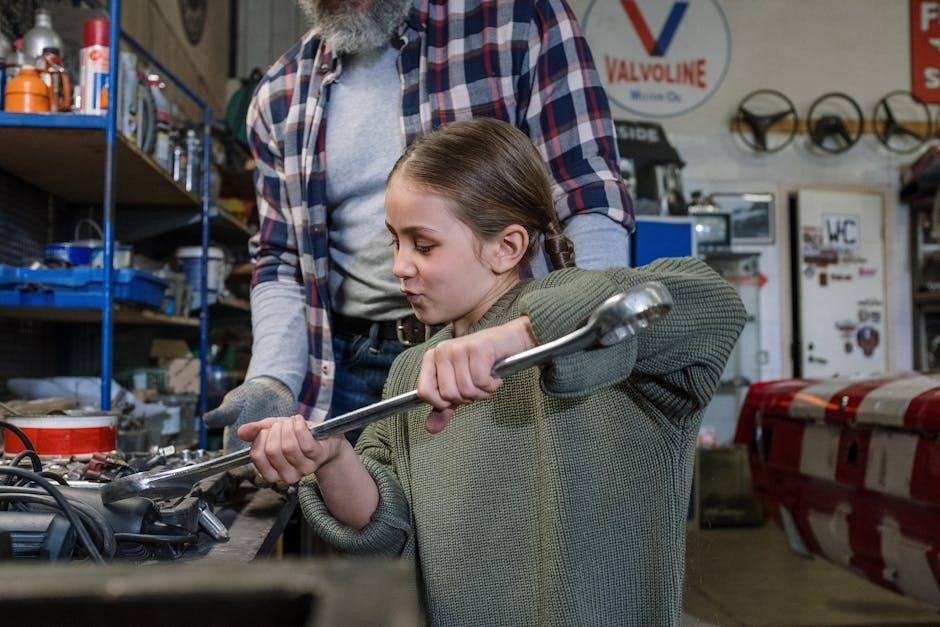The Cessna 150 Maintenance Manual is a comprehensive guide essential for ensuring the safety, longevity, and optimal performance of the aircraft. It provides detailed procedures, inspection schedules, and technical specifications to help pilots, mechanics, and owners maintain the Cessna 150 series effectively. Available in digital formats like PDF, the manual is organized for easy navigation, covering everything from routine checks to complex repairs. It serves as a vital resource for anyone involved in the upkeep of this iconic aircraft.
Overview of the Cessna 150 Series
The Cessna 150 series is a popular single-engine aircraft known for its reliability and versatility. Introduced in the 1950s, it quickly became a favorite for flight training and personal use due to its durability and ease of handling. The series includes various models such as the 150, 152, and Aerobat, each designed for different purposes, from training to aerobatics. Equipped with the Continental O-200 engine, the Cessna 150 offers excellent performance and fuel efficiency. Its simplicity in design makes it a cost-effective choice for maintenance and operation, ensuring it remains a cornerstone in aviation.
Importance of Regular Maintenance for Safety and Longevity
Regular maintenance is critical to ensuring the safety and longevity of the Cessna 150. Adhering to the guidelines in the maintenance manual helps prevent mechanical failures and ensures compliance with airworthiness standards. Neglecting routine inspections can lead to minor issues escalating into costly repairs or safety hazards. Proper upkeep extends the lifespan of components like the Continental O-200 engine, which, with careful maintenance, can exceed its recommended TBO. Consistent checks also enhance fuel efficiency and overall performance, making regular maintenance indispensable for both safety and cost-effectiveness.
Structure and Organization of the Maintenance Manual
The Cessna 150 Maintenance Manual is a comprehensive guide organized into clear sections, including detailed procedures, inspection schedules, and technical specifications. Available in digital formats like PDF, it ensures easy navigation and accessibility for mechanics and owners, covering everything from basic maintenance to complex repairs efficiently.
Understanding the Sections and Appendices
The Cessna 150 Maintenance Manual is divided into clear sections, each addressing specific aspects of aircraft maintenance. The manual includes detailed inspection procedures, troubleshooting guides, and repair instructions. Appendices provide supplementary information, such as parts lists, torque specifications, and compliance requirements for airworthiness directives. This organization ensures that users can quickly locate relevant information, making the manual an indispensable tool for maintaining the Cessna 150 series. Its clarity and comprehensiveness simplify complex maintenance tasks, ensuring safety and efficiency;
Navigating the Manual for Specific Tasks
The Cessna 150 Maintenance Manual is structured to help users efficiently locate specific information. It features detailed tables of contents, indexes, and clear section headings, allowing quick access to relevant procedures. Appendices provide additional resources, such as diagrams and charts, to support complex tasks. Each section is categorized by maintenance type, ensuring that pilots and mechanics can rapidly find instructions for inspections, repairs, or upgrades. This organized approach streamlines maintenance processes, reducing downtime and enhancing overall efficiency.
General Maintenance Procedures
Regular maintenance tasks ensure the Cessna 150 operates safely and efficiently. Daily inspections, routine checks, and adherence to guidelines are crucial for longevity and performance.
Daily Pre-Flight Inspections
Daily pre-flight inspections are critical for ensuring the Cessna 150 is airworthy. Pilots must visually inspect control surfaces, fuel lines, tires, and brakes for damage or wear. Check propeller blades for nicks or cracks, and verify proper pitch adjustment. Examine the aircraft’s exterior for signs of corrosion or structural damage. Test all flight controls for proper movement and function. Ensure all necessary fluids, such as oil and fuel, are at appropriate levels. Review the aircraft’s logbooks to confirm compliance with maintenance requirements. These checks help identify potential issues before they escalate, ensuring a safe and successful flight.
Post-Flight Checks and Routine Maintenance
Post-flight checks ensure the Cessna 150 remains in optimal condition. After landing, secure the aircraft and inspect for damage or leaks. Check tire pressure and brake functionality. Draining fuel samples from tanks helps detect contamination. Routine maintenance includes lubricating moving parts and verifying fluid levels. Log all findings and schedule repairs as needed. Regularly cleaning the aircraft prevents corrosion. These steps ensure the plane is ready for the next flight and maintain its longevity. Consistent post-flight routines are essential for safety and reliability.
Engine Maintenance and Overhaul
Regular engine inspections and overhauls are critical for the Cessna 150’s performance and longevity. The Continental O-200 engine typically exceeds TBO with proper care. Follow manual guidelines for inspections and repairs to ensure reliability and safety.
Frequency of Engine Overhaul and Inspection
The Continental O-200 engine in the Cessna 150 typically exceeds its recommended time between overhauls (TBO) of 1,800 hours with proper maintenance. Part 91 operators are not required to overhaul the engine but must repair as needed throughout its lifespan. Regular inspections, including compression checks and oil analysis, are crucial for early detection of wear. The manual recommends routine inspections every 50 hours and a detailed annual inspection to ensure compliance with airworthiness standards. Adhering to these intervals helps prevent unexpected failures and ensures optimal engine performance.
Top Overhaul vs. Major Overhaul: Key Differences
A top overhaul focuses on replacing the engine’s cylinders, pistons, and rings, while a major overhaul involves disassembling the entire engine to inspect and replace all components. A top overhaul is less extensive, typically addressing wear on moving parts, and can be completed in about 40 hours. A major overhaul is more comprehensive, requiring up to 200 hours, and ensures the engine meets factory specifications. Both procedures are essential for maintaining the Continental O-200 engine’s reliability and performance in the Cessna 150.
Specific Tips for the Continental O-200 Engine
Regular oil analysis and filter inspections are crucial for monitoring engine health. Always use the recommended oil grade to prevent premature wear. During pre-flight checks, ensure the fuel/air mixture is properly adjusted to optimize performance and reduce cylinder head temperatures. Avoid aggressive lean-of-peak operations, as they can stress the engine. Inspect spark plugs annually and replace them every 500 hours or as needed. Clean or replace the air filter frequently to maintain proper airflow. Properly secure all connections to prevent vibration-induced damage. These practices ensure the Continental O-200 engine operates efficiently and reliably.

Airframe Inspection and Maintenance
Airframe inspection involves thorough visual checks for damage, corrosion, and wear. Regular maintenance ensures structural integrity, safety, and longevity of the Cessna 150;
Annual Inspection Requirements
The annual inspection is a detailed examination of the Cessna 150’s airframe, ensuring compliance with safety standards. It includes visual checks of wings, fuselage, and control surfaces for damage or corrosion. Mechanics inspect rivets, bolts, and welds for integrity. All systems, including fuel, electrical, and hydraulic, are evaluated. Compliance with Airworthiness Directives (ADs) is verified. The inspection ensures the aircraft remains airworthy, addressing any wear or defects. Proper documentation of findings and repairs is essential for maintaining legal and safe operation.
Corrosion Prevention and Control
Corrosion prevention is critical to maintaining the structural integrity of the Cessna 150. Regular inspections focus on high-risk areas like wing spars, fuel tanks, and control surfaces. Visual checks and detailed examinations help identify early signs of corrosion. Treatment involves cleaning affected areas and applying protective coatings or sealants. Draining moisture from fuel tanks and using corrosion-inhibiting compounds is recommended. Protecting the aircraft from harsh environmental conditions, such as coastal humidity, is essential. Adhering to the manual’s guidelines ensures effective corrosion control, safeguarding the aircraft’s longevity and safety.
Inspecting Control Surfaces for Damage
Inspecting control surfaces for damage is a critical step in maintaining the Cessna 150’s airworthiness. Begin with a visual examination of the ailerons, elevators, and rudder for signs of dents, cracks, or corrosion. Check hinges and attachment points for proper alignment and security. Ensure all surfaces move freely without binding or excessive play. Examine leading edges for erosion or impact damage. Any discrepancies should be documented and addressed promptly to maintain flight safety and prevent further deterioration. Regular inspections help identify issues before they escalate, ensuring optimal aircraft performance and compliance with airworthiness standards.
Avionics and Electrical Systems
The Cessna 150’s avionics and electrical systems require meticulous maintenance to ensure reliable performance. Regularly inspect circuits, wiring, and components for damage or wear. Troubleshoot electrical issues promptly to prevent system malfunctions. Updates to avionics should follow manufacturer guidelines to enhance safety and functionality. Proper installation and removal of electrical components are critical to maintain system integrity and prevent potential failures during flight.
Troubleshooting Common Electrical Issues
Troubleshooting electrical issues in the Cessna 150 involves identifying faults in wiring, connectors, and components. Start by inspecting for loose connections, corrosion, or damaged wires. Use diagnostic tools to trace circuits and isolate malfunctions. Common problems include faulty circuit breakers, malfunctioning avionics, or incorrect wiring configurations. Always refer to the manual for specific procedures and part numbers. Addressing electrical issues promptly is crucial to prevent system failures and ensure safe operation. Regular maintenance and inspections can help mitigate these problems before they escalate.
Updating and Maintaining Avionics Systems
Updating and maintaining avionics systems in the Cessna 150 is critical for ensuring reliable navigation, communication, and flight control. Regularly inspect wiring and connections for wear or corrosion. Software updates should be performed in accordance with manufacturer guidelines to enhance functionality and compatibility. Test all systems, including GPS, autopilot, and weather radar, after any modifications. Refer to the maintenance manual for specific procedures and compliance with airworthiness directives. Properly maintained avionics ensure accurate performance, improving safety and operational efficiency. Always consult certified professionals for complex upgrades or repairs.
Installation and Removal of Electrical Components
Installing or removing electrical components in the Cessna 150 requires careful adherence to the maintenance manual. Always disconnect power sources before starting work to prevent electrical shocks. Use approved tools and follow manufacturer guidelines for secure connections. Ensure all wiring is properly routed and secured to avoid damage. After installation, test all systems to confirm functionality. Regularly inspect electrical components for wear or corrosion, and replace them as needed. Proper documentation of all modifications is essential for compliance with airworthiness standards.Consult certified professionals for complex electrical tasks.

Landing Gear and Tire Maintenance
Regular inspection of the landing gear and tires ensures safety and durability. Check for damage, wear, and proper lubrication; Monitor tire pressure and tread wear. Adhere to manual guidelines for replacement and maintenance to prevent failure during operations.
Inspecting and Lubricating the Landing Gear
Regular inspection of the landing gear is crucial for ensuring safety and performance. Visually examine for damage, wear, or corrosion. Lubricate all moving parts, including pivot pins and hinges, to prevent friction and corrosion. Check hydraulic lines for leaks and ensure all bolts and nuts are secure. Refer to the manual for specific lubrication intervals and methods. Proper maintenance prevents malfunctions during takeoff, landing, and taxiing, ensuring the landing gear operates smoothly and reliably under various conditions.
Tire Pressure and Wear Inspection
Regular inspection of tire pressure and wear is essential for safe and efficient aircraft operation. Check tire pressure when cold, using a reliable gauge, and ensure it matches the specifications in the maintenance manual. Visually inspect tires for uneven wear, cracks, or damage. Uneven wear may indicate misalignment or improper inflation. Replace tires if excessive wear or damage is found. Proper tire maintenance enhances safety, improves landing performance, and prevents potential failures during ground operations. Always adhere to the manual’s guidelines for tire care and replacement.
Replacing Tires and Brake Pads
Replacing tires and brake pads on the Cessna 150 requires careful adherence to the maintenance manual. Begin by ensuring the aircraft is on level ground and securely supported with jack stands. Remove the old tires and inspect the wheels for damage. Install the new tires, ensuring they are properly seated and inflated to the recommended pressure. For brake pads, remove the old ones, inspect the brake assembly, and install new pads according to the manual’s specifications. Tighten all components to the recommended torque settings to ensure safe and reliable operation. Always follow the manual’s guidelines for replacement procedures;

Hydraulic and Braking Systems
Ensuring the hydraulic system operates flawlessly is critical for safe landing gear operation and braking. Regularly check hydraulic fluid levels and inspect for leaks or damage. Troubleshoot brake issues promptly and adhere to manual guidelines for maintenance and repairs.
Maintaining Hydraulic Fluid Levels
Regularly inspect the hydraulic fluid levels in the Cessna 150 to ensure proper braking and landing gear operation. Use the dipstick provided to check the fluid level, ensuring it meets the manufacturer’s specifications. Top up with the recommended hydraulic fluid if levels are low. Inspect the reservoir and lines for leaks or damage, addressing any issues promptly to prevent system failure. Proper fluid maintenance is crucial for reliable braking performance and overall aircraft safety, as outlined in the maintenance manual.
Troubleshooting Brake System Issues
Identify brake system problems by checking for spongy brakes, fluid leaks, or reduced stopping power. Inspect the master cylinder, brake lines, and calipers for damage or wear. Ensure brake pads are within acceptable thickness limits and replace them if worn. Verify the parking brake is fully released, as partial engagement can cause drag. Consult the maintenance manual for specific troubleshooting steps and adjust or replace components as needed. Addressing brake issues promptly ensures safe landing and taxi operations, adhering to the guidelines outlined in the manual.

Propeller Maintenance
Regular propeller inspections ensure safety and performance. Check for damage, nicks, or erosion. Adjust pitch as needed and balance the propeller for smooth operation, following manual guidelines.
Inspecting the Propeller for Damage
Regular propeller inspections are crucial for ensuring safety and performance. Visually examine the blades for cracks, nicks, or erosion. Check the hub for wear or corrosion. Inspect the leading edges for signs of impact or abrasion. Ensure proper blade alignment and balance. Refer to the manual for specific inspection procedures and tolerances. Address any damage promptly to prevent vibration and maintain efficient engine operation. Neglecting propeller inspections can lead to costly repairs or compromised flight safety.
Adjusting Pitch and Balancing
Proper propeller pitch adjustment ensures optimal engine RPM and aircraft performance. Use a protractor to measure and set the blades at the recommended angle. For balancing, install the propeller and use a balancer to achieve static balance. Ensure even weight distribution to minimize vibrations. Refer to the manual for specific pitch settings and balancing procedures. Regular adjustments maintain efficiency and reduce wear on the engine and airframe, ensuring smooth operation during flight.
Fuel and Oil Systems
Regular inspection of fuel lines and tanks ensures leak-free operation. Monitor oil levels and filters to maintain engine health. Prevent contamination to avoid damage, ensuring smooth engine performance and longevity.
Inspecting Fuel Lines and Tanks
Regular inspection of fuel lines and tanks is crucial for maintaining aircraft safety and performance. Check for leaks, corrosion, or damage to fuel lines and connections. Ensure tanks are properly sealed and free from contaminants. Inspect fuel caps, vents, and drain valves for proper function. Look for signs of wear or deterioration in fuel line flexible sections. Drain fuel tanks annually to check for water or debris contamination. Proper inspection ensures reliable fuel delivery and prevents engine failure during flight. Always follow manual guidelines for detailed procedures and safety precautions.
Managing Oil Levels and Filters
Regular oil level checks are essential to ensure engine longevity. Always use a clean dipstick and verify levels against the manual’s specifications. Change oil every 25-50 hours of flight time, using the recommended grade and viscosity. Inspect oil filters for metal particles or debris during routine maintenance. Replace filters at each oil change to prevent contamination. Proper oil management prevents engine overheating and premature wear. Always follow the Cessna 150 Maintenance Manual’s guidelines for oil service intervals and filter replacement to maintain optimal engine performance and reliability.
Preventing Contamination
Preventing contamination in the Cessna 150’s fuel and oil systems is crucial for maintaining engine performance and longevity. Regularly inspect fuel tanks and lines for debris, rust, or leaks. Use high-quality fuel filters and replace them as recommended. When handling oil, ensure the area is clean, and use new, sealed oil cans to prevent dirt or moisture from entering the system. Clean all tools and equipment before use to avoid introducing contaminants. Always follow the manual’s guidelines for proper drainage and disposal of hazardous materials to maintain a safe and efficient aircraft.
Safety Considerations and Emergency Procedures
Safety is paramount in maintaining the Cessna 150. Adhere to all airworthiness directives and ensure emergency procedures are well-understood. Regular inspections and proactive maintenance are critical to preventing issues and ensuring preparedness for unforeseen situations.
Compliance with Airworthiness Directives (ADs)
Compliance with Airworthiness Directives (ADs) is critical for ensuring the safety and airworthiness of the Cessna 150. ADs are mandatory instructions issued by aviation authorities to address specific safety concerns or defects. The Cessna Aircraft Company has introduced supplemental inspection procedures to enhance maintenance requirements, particularly for aging aircraft. Regular inspections and adherence to updated maintenance practices, as highlighted by John Bushell of the CAA, are essential to prevent potential issues. Failure to comply with ADs can lead to serious safety risks and legal consequences. Always ensure all ADs are meticulously tracked and implemented by certified professionals.
Emergency Procedures for System Failures
Emergency procedures for system failures in the Cessna 150 require immediate and precise actions to ensure safety. Pilots must remain calm, assess the situation, and follow established protocols. In case of engine failure, securing the engine and preparing for an emergency landing is critical. Electrical or hydraulic system malfunctions demand quick isolation of affected components. Communication with air traffic control (ATC) is essential for guidance and assistance. Always refer to the Cessna 150 Maintenance Manual for specific instructions and ensure all emergency procedures are practiced regularly to enhance response readiness in critical situations.
The Cessna 150 Maintenance Manual is a vital resource for ensuring safety, longevity, and optimal performance. It provides comprehensive guidance for pilots, mechanics, and owners, emphasizing the importance of regular inspections and adherence to specified procedures to maintain aircraft integrity and reliability.
Final Thoughts on Effective Maintenance Practices
Effective maintenance practices for the Cessna 150 require a proactive approach, emphasizing regular inspections and adherence to the manual. Owners and mechanics must stay informed about airworthiness directives and recommended overhaul frequencies. Proper care of the engine, airframe, and systems ensures safety and extends the aircraft’s lifespan. Digital manuals offer convenient access to detailed procedures, while community resources and forums provide additional support. Consistent adherence to these practices fosters reliability and enhances the overall flying experience.
Resources for Further Reading
For deeper understanding, refer to the official Cessna 150 Service Manual (1969-1976) and the Cessna 100 Series Service Manual for broader insights. Online forums and communities, such as aviation maintenance groups, offer practical tips and real-world experiences. Websites providing free PDF downloads of these manuals are invaluable. Additionally, Cessna’s official publications and manufacturer websites provide authoritative guidance. These resources collectively enhance maintenance knowledge and ensure compliance with best practices for the Cessna 150.


